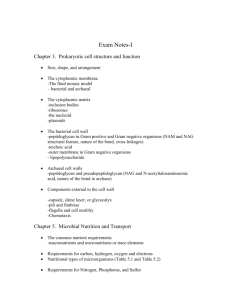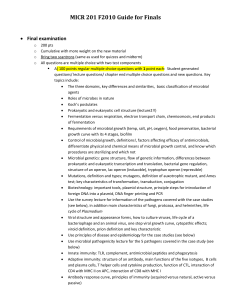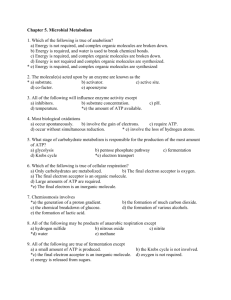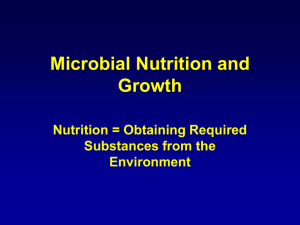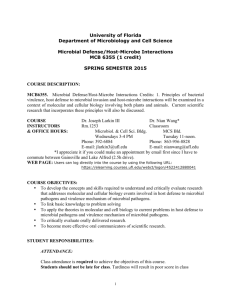MICR 201 Microbiology for Health Related Sciences
advertisement
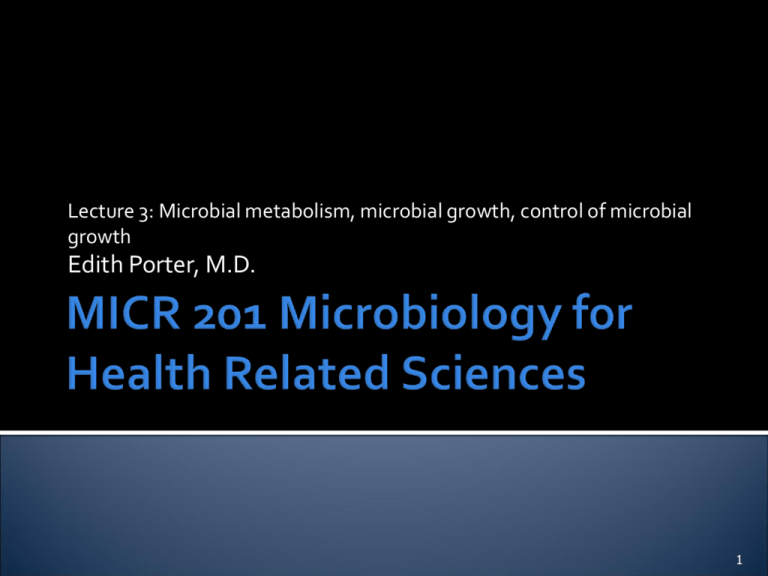
Lecture 3: Microbial metabolism, microbial growth, control of microbial growth Edith Porter, M.D. 1 Microbial metabolism Microbial growth Overview Enzymes and cofactors Oxidation Reduction reactions ATP generation Respiration and fermentation Biosynthesis Physical requirements Chemical requirements Biofilm Bacterial growth curve Control of microbial growth Terminology Microbial death rate and actions of microbial control agents Physical methods Chemical methods Microbial resistance to control agents 2 3 Metabolism is the sum of all chemical reactions within a living cell Includes catabolism and anabolism Catabolism Complex organic molecules converted to small simple compounds Releases energy Anabolism Simple compounds converted to complex organic molecules (biosynthesis) Consumes energy Metabolism= Catabolism + Anabolism 4 Chemical reactions accelerated by Temperature increase Enzymes Enzymes (xxx-ase) Mostly proteins Specific for certain reactions Not changed upon the reaction Typically re-usable Some require co-factor or coenzyme for activity ▪ Co-factor: Ions (magnesium,calcium) ▪ Co-enzyme: organic molecule; many are derivates from vitamines, e.g. NAD+ and NADP+ 5 6 Temperature (if too high: enzyme becomes denatured) pH (if too extreme: enzyme becomes denatured) Substrate concentration Inhibitors E.g. cyanide, arsenic, mercury Block enzymes that require metal ions Tie up metal ion activators of enzymes 7 Based on the chemical reaction Oxido-reductases: oxidation-reduction reaction in which oxygen and hydrogen are gained or lost Transferases: transfer of functional groups Hydrolases: cleavage of molecules with hydrolysis (addition of water) Lyases: removal of groups of atoms without hydrolysis Isomerases: rearrangement of atoms within a molecule Ligases: joining of 2 molecules Based on the target Protease Lipase DNAse RNAse 8 Basic reaction : electron uptake : electron removal Biological reaction 9 Adenosine Tri Phosphate ADP + energy + phosphate ATP contains energy that can be easily released (highenergy or unstable energy bond) Required for anabolic reactions Produced by Substrate-level phosphorylation (fermentation): direct transfer of phosphate group from one molecule to the next C-C-C~ P + ADP C-C-C + ATP Oxidative phosphorylation (respiration): involves electron transport chain, oxidation-reduction reactions and inorganic phosphate ADP + ATP P C D 10 Important electron carriers NAD+ FMN FAD Important oxidase Cytochrome oxidases E.g. cytochrome C oxidase 11 The electron flow is coupled to H+ efflux via proton pumps H+ accumulates outside and a chemical and charge based gradient is generated (potential energy) Special protein channels allow H+ flux back into the cell Re-entering of H+ into the cell generates energy for ATP Motility Active transport 12 2 ATP (energy entrapped in organic compounds) 36 ATP 13 CO2 and H2 gas production! Acid production will lower pH!!! 14 Grapes and yeast: wine Grain and yeast: beer Milk and lactobacilli: yogurt Milk and lactobacilli and propionibacteria: swiss cheese Ethanol and Acetobacter: vinegar And many more… 15 Part of electron transport chain Membrane-bound, water soluble enzyme Found in some bacteria like Pseudomonas aeruginosa or Neisseria Can be easily detected by adding to the grown cultures a substrate that changes color when oxidized “oxidase positive” 16 Single sugar + protein + pH indicator+ Durham tube Inoculate organism and incubate for 24- 48 h Gas Turbid = growth Yellow/orange = acid 17 Glucose: to test for ability to conduct fermentation Lactose: many intestinal pathogens are lactose negative! Mannitol: used to screen for Staphylococcus aureus which is able to ferment mannitol 18 Group of important organisms that are under no circumstances able to perform fermentation Only respiration is possible Example: Pseudomonas aeruginosa Non-fermenters play a role as opportunistic pathogens in the hospital setting 19 20 21 Respiration Complete oxidation of glucose to carbon dioxide and water while ATP is generated Involves glycolysis, krebs cycle and extensive electron transport chain Higher energy yield, faster growth Fermentation Anaerobic process Involves glycolysis and production of organic compound Low energy yield, slower growth 22 23 Physical Temperature Osmotic pressure ▪ Salt: halophil ▪ High salt (Halobacterium spec. requires 30% !!) pH ▪ Low pH (1.0 -2.0): acidophil ▪ High pH (> 8.0): alkaliphil Chemical Elements: ▪ Macroelements: C, N, S, P ▪ Trace elements: iron, copper, zinc Atmosphere ▪ Oxygen ▪ CO2 -PHIL MEANS MUST HAVE!!! 24 Psychrophiles: -10 to 20C Psychrotrophs: 0 to 30 C Mesophiles: 10 to 48C Thermophiles: 40 to 72C Hyperthermophile: 65 to 110C Only Archaea can grow above 95C! 25 Some pathogens can multiply in the refrigerator: Listeria monocytogenes 26 Similar effect with sugars 27 Oxygen is readily converted into radicals (singlet oxygen, superoxide, hydrogen peroxide, hydroxyl radical) Most important detoxifying enzymes are superoxide dismutase and catalase Cells differ in their content of detoxifying enzymes and hence, ability to grow in the presence of oxygen 28 Type of Bacteria Catalase Superoxide Dismutase Oxygen and Growth Obligate aerobes + + Require oxygen Facultative anaerobes + + Can proliferate with and without oxygen Obligate anaerobes - - Cannot survive oxygen, must have anaerobic conditions Aerotolerant anaerobes - + Survive oxygen but cannot use it for growth (+) (+) Microaerophiles Require low levels of oxygen 29 Classification of gram-positive cocci Staphylococci are catalase + Streptococci are catalase - Staphylococci Streptococci 30 Enhanced CO2 concentration (5%) Capnophile Many mucosal pathogens are capnophile 31 Most pathogens Are mesophiles Require moderate pH Require physiological salt concentrations Require an atmosphere To prevent spoilage Refrigeration Acidity Add salt or high concentrations of sugar Vacuum package 32 Average reproduction rate of E. coli: ~ 20 minutes 33 34 Lag phase Bacteria adjust to new medium Log phase: Logarithmic growth, all cells in the same growth phase Stationary phase: Nutrients limited, population very inhomogeneous, Bacilli/Clostridia: sporulation; Some pathogens upregulation of virulence factors Biofilm production Decline phase: Accumulated toxic products, nutrients exhausted 35 36 XX-phile Requires XX for growth Ability to survive oxygen depends on the presence of enzymes that detoxify oxygen radicals The typical growth curve of bacteria includes lag, log, stationary and decline phase 37 38 Disinfection: removal of potential vegetative pathogens on in-animated objects (disinfectants) Antisepsis: removal of potential vegetative pathogens on tissues (antiseptics) Sterilization: eliminates all forms of microbial life (and prions) Commercial sterilization: killing of C. botulinum endospores Sanitization: generates safe conditions for the public Degerming: modified antisepsis, mechanical removal of microbes with alcohol patch Pasteurization: eliminates pathogens and spoilage microbes 39 -cidal: to kill, reduce numbers of viable microbes -static: to prevent growth and proliferation Add antimicrobial CFU/ml Time [h] 40 Alteration of Membrane permeability Damage to Proteins Disulfide bridges Hydrogen bonds Damage to Nucleic acids Strand brakes Dimerization Loss of activity Errors in proteins with loss of function or no protein at all 41 Microbial population number, composition Concentration of agent Exposure time Environment 70% EtOH is more effective than 95% EtOH Heat works better at low pH! Temperature pH Pressure Presence of organic material 42 Physical Chemical Heat Liquids Cooling Gas Filtration Pressure Desiccation Radiation 43 Moist sterilization under pressure Exposure time: 15 min 121° C at 15 psi High pressure and high heat Special training is required to use an autoclave 44 How can you prove that the autoclave is properly functioning and fulfills the requirements to Eliminate ALL microbial life forms? 45 Dry-heat sterilization 2 – 3 hrs 160 – 170° C Prevents corrosion Suited also for powders 46 Kills pathogens, reduces spoilage organisms Introduced by L. Pasteur in 1860s in wine production Today: 30 min 63° C Flash: 15 sec 72° C 30 min 55 – 60 ° C Better taste Ultra high temperature treatment for milk 1 – 3 sec 140 – 150 ° C 47 0.2 (0.45) mm pore size Limitations Cell wall less microbes (e.g. mycoplasma) are not removed Viruses, nanobacteria not removed Problem in cell culture laboratories Specialty filters with 0.01 mm pore size Other material may adhere to the filters HEPA filter with 0.3 mm pore size filter air that go into special rooms 48 Most pathogenic bacteria do not replicate at 4C (static effect) Exception: Listeria monocytogenes Freezing: most damage occurs during thawing Some worms are killed during storage at subzero 49 High atmospheric pressure Prevent spoilage and preserve taste Fruit juices Osmotic pressure Hypertonic High salt or high sugar Used in food preservation However, often molds can still grow 50 Prevents typically proliferation but does not kill Exception: Neisseria gonorrhoeae Bacterial spores in particular resistant to desiccation Survive for thousands of years Problem: dried pus, urine, feces in hospital setting (mattresses…) http://prokariotae.tripod.com/Nei sseria_gonorrhoeae.jpg http://www.acmp.com.au/portfolios/mischk ulnig/images/hospital-bed.jpg 51 Ionizing (< 1nm wavelength) Gamma-rays (used for spices), x-rays, high-energy electron beams Ionize water hydroxyl radicals damage of DNA and other molecules Non-ionizing UV light (1 – 400 nm, 260 nm!) Thymine dimerization 52 Ethylene oxide Denatures proteins, attacks SH-, COOH- OH- groups Highly penetrating Sterilize in closed chamber 4 – 18 hours Medical supplies, space crafts, mattresses Caution: cancerogenic 53 Agent Mechanism Preferred Use Examples Phenol based Disruption of membrane, protein denaturation Hospitals, work well in the presence of organic material, Mycobacteria Amphyl Triclosan Biguanide Disruption of membrane Surgical scrubs Chlorhexidine Halogenes Strongly oxidizing Cellular function and structures altered Wound treatment (I2) Household (CL2) Povidoneiodine Chlorox Alcohol Protein denaturation Dissolution of membrane Thermometer Skin scrubbing (alcohol pads) Ethanol Isopropanol Aldehydes Protein cross linker Fixative Surgical Instruments Formalin Glutaraldehyde Peroxygenes Oxidation Deep wounds with anaerobes Peracetic acid Detergents Membrane disruption Protein denaturation Industrial Instrument sanitizers Soap Zephiran 54 Organic acids in food and cosmetics Sorbic acid Benzoic acid Heavy metals (copper, silver, zinc) Copper: as algicide, copper coated cell incubators Silver nitrate: prevention of ophthalmica neonatarum, wound treatment Zinc chloride: wound treatment Antibiotics (NOT as DRUG!!) Nisin and natamycin in cheese 55 Major concern Endospores Mycobacteria Prions ▪ 134C autoclaving and sodium hydroxide not 100% effective 56 You try ..... 57 Look in your household and identify antimicrobial additives. Bring a list describing 2 items, the antimicrobial additives incorporated (must be 2 different ones), and their mode of action in table format (as shown to the left) to class. Complete tables will be worth 5 points Item Antimicrobial Additive Mode of Action 58
